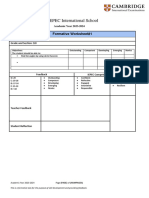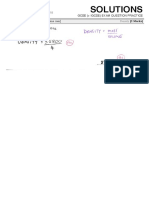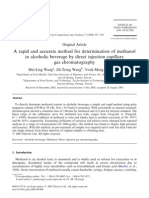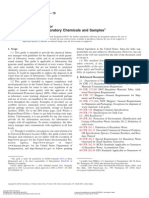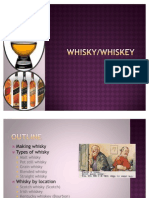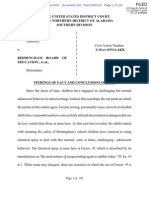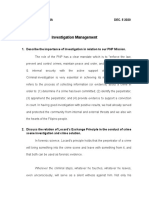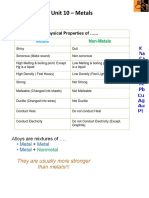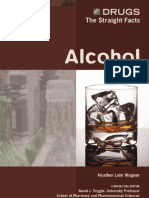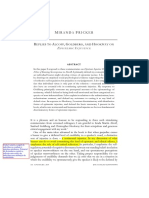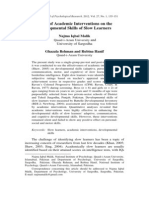Non Commercial Alcohol
Non Commercial Alcohol
Uploaded by
Ki Ageng Pangrekso BuwonoCopyright:
Available Formats
Non Commercial Alcohol
Non Commercial Alcohol
Uploaded by
Ki Ageng Pangrekso BuwonoOriginal Description:
Copyright
Available Formats
Share this document
Did you find this document useful?
Is this content inappropriate?
Copyright:
Available Formats
Non Commercial Alcohol
Non Commercial Alcohol
Uploaded by
Ki Ageng Pangrekso BuwonoCopyright:
Available Formats
MODULE 21: NONCOMMERCIAL ALCOHOL
Summary:
Noncommercial alcohol exits in many forms, both licit and illicit, and is estimated to account for
a significant portion of all alcohol consumed worldwide.
Since noncommercial alcohol is not taxed, regulated, or recorded, there is a dearth of information
about the patterns of its consumption and related outcomes.
Traditional home-produced beverages are part of the local culture of many countries and generally
are not associated with increased risk for harm.
In some countries, noncommercial alcoholespecially illicit, counterfeit, or smuggled
beveragesrepresents a serious social, economic, and public health problem.
Problematic drinking patterns around noncommercial alcohol are often the result of complex
social and economic conditions and may be influenced by restrictive government policies.
Harm reduction approaches can be applied successfully to prevent the harm and to develop
policies around noncommercial alcohol.
Noncommercial alcohol goes by many names: moonshine, bootlegged, local, illicit, or unrecorded
alcohol. It includes alcohol beverages that are not produced within a commercial setting and are
therefore not reflected in official statistics, such as sales figures. These beverages are largely
outside of government control and as a result are not taxed. Finally, noncommercial alcohol is
often not subject to the same standards of quality and purity as its commercially produced
counterparts.
Noncommercial alcohol accounts for at least two thirds of all alcohol consumption in the Indian
subcontinent, about half of consumption in Africa, and about one third in eastern Europe and
Latin America (World Health Organization, 2004, p. 15). However, the lack of data about
noncommercial alcohol makes research into the drinking patterns around it difficult. There is
currently a dearth of scientific evidence about noncommercial alcohol, its production,
consumption patterns, and related outcomes (Gudmundsdottir, 1988; Heath, 2000; Larson &
Hanson, 1992; Martinic, 1998; Nordlund, Holme, & Tamsfoss, 1994).
Although the production of many noncommercial beverages meets high standards of quality
(Haworth & Simpson, 2004), a lot of what is included under this heading is of poor quality, often
contaminated and toxic. This latter category represents a serious public health problem in many
countries, particularly in the developing world and in countries undergoing rapid social and
economic transition (Grant, 1998; Ryan, 1995).
Types of noncommercial alcohol
Noncommercial alcohol is found in virtually every country around the world and includes a range
of traditional drinks that are home-produced, largely for personal consumption, but also for sale.
Another category includes beverages that are produced illegally for commercial (but illicit sale)
or counterfeit alcohol that is passed off as commercial products.
21-2 Updated: April 2005
Available at: www.icap.org
Traditional beverages
Noncommercial alcohol often takes the form of traditional beverages that reflect the local
drinking culture and occupy a particular place within a given society. These beverages may be
distilled, fermented, or brewed from a wide range of different ingredients. For example (Haworth
& Simpson, 2004):
In Brazil, cachaa, a distillate made from sugarcane, is the national alcohol beverage.
Cachaa is produced both legally and illegally. While exact figures are lacking, there is
evidence that the overwhelming proportion of production is illicit. Out of the distilleries in
just a single Brazilian state, for example, only 10% are registered. The remaining 90%
produce noncommercial cachaa.
In Mexico, traditional alcohols run the gamut from tequila to pulque and aquardiente. While
tequila and aguardiente may be both legally and illegally produced, pulque (fermented from
the agave plant) is a noncommercial beverage type found most commonly in rural areas.
In Zambia, the most popular types of beverages are homebrewed beers (opaque beers) and
kachasu, a distilled spirit made of sorghum, maize, sour beer, sugar, and yeast.
Russian samogon, distilled spirits with similar alcohol content to vodka, is not commercially
produced but typically made in the home.
Although Hungarian palinkas, or fruit brandies, may be produced and purchased
commercially, they are largely produced as noncommercial products.
Traditional beverages in India include toddy, fermented from the flower of coconut and other
palms, urrack, a distillate from the fruit of the cashew tree, and arrack, distilled from paddy
or wheat.
In the Mediterranean regions of France, Italy, Spain, Greece, Croatia, and other countries,
home production of wine is a long-standing tradition.
The production and drinking patterns accompanying the consumption of traditional alcohol is an
integral part of many local cultures (Heath, 2000; Mateos, Paramo, Carrera, & Rodriguez Lopez,
2002). For example, communal drinking of local beers from a common vessel is part of the
drinking culture in many rural areas of Africa.
Traditional beverages are mostly produced noncommercially, generally for personal
consumption, but also for sale. Some countries allow the home production of a certain amount of
beverage alcohol for sale. As a result, most traditional beverages are of high quality in order to
encourage repeat customers to buy a particular product (Nuzhnyi, 2004).
However, not all products are of consistent quality. Many local alcohols are contaminated, toxic,
and, thus, represent a health hazard (Mosha, Wangabo, & Mhinzi, 1996). Even when one
excludes the deliberate adulteration of beverages and the use of dangerous and low-quality
ingredients to produce cheap beverage alcohol, the production process itself may pose
considerable risk. For example, there have been reports of local beers brewed in old oil drums,
thereby introducing toxic contaminants. Similarly, the fermentation process of pulque often relies
on the use of animal excrement that contributes to high levels of bacterial contamination,
representing a significant health risk (Rosovsky, 2004).
21-3 Updated: April 2005
Available at: www.icap.org
Illicit alcohol
While traditional beverages produced and consumed in the home environment represent much of
noncommercial alcohol, a large proportion of it is illicit and is made for the purposes of sale
(Rossow, 2003). This includes (Lemmens, 2000; Room & West, 1998):
Beverages produced commercially but passed on informally, for example by smuggling or
cross-border trade (Willis, 2003). For instance, where taxes are high, other jurisdictions can
offer the same product for a lower price on the black market. In other cases, consumers
themselves may purchase beverage alcohol in neighboring countries where the taxes are
lower.
Beverages produced illegally but for commercial (often illicit) sale. This includes poor
quality products manufactured and sold cheaply. There have been numerous reports of
contamination of very cheap beverage alcohol with methanol or battery acid (e.g., Willis,
2003). Counterfeit beverage alcohol, packaged as legitimate commercial products, is a
serious problem in some countries, particularly where the substituted product is of poor
quality. Such illicit alcohol becomes the alternative of choice especially in countries where
sales and production may have been severely restricted (e.g., in the Soviet Union during the
1980s).
In addition to being a public health concern, illicit alcohol production and trade are also often
associated with organized crime and thus represent a significant public order and safety issue
(e.g., J unninen & Aromaa, 2000).
Public health and social considerations
What people drink is one of the key components of drinking patterns and can be at least as
important as how much they drink. This includes both commercially produced and
noncommercial alcohol, legal and illicit. The quality of the product has a significant impact on
the potential health outcomes for its consumers.
As with commercially produced beverages, moderate drinking patterns of high quality traditional
beverages and noncommercial alcohol are associated with health benefits for many people.
However, noncommercial alcohol that is contaminated or in some way adulterated presents a
serious risk to health (Holstege, Ferguson, Wolf, Baer, & Poklis, 2004). For example, methanol
contamination can lead to blindness and even death, and there have been reports of bad batches of
beverages contaminated by methanol, lead, and arsenic from countries around the world abound
(Haworth & Simpson, 2004, pp. 67; Holstege et al., 2004; Hudson, Crecelius, & Gerhardt, 1980;
Silverberg, Chu, & Nelson, 2001; Tonkabony, 1975). Similarly, high levels of liver cirrhosis have
been reported among those who drink beverages with the bacterial contamination, even when
these individuals are not heavy or frequent drinkers (Lovelace & Nyathi, 1977).
For the purposes of prevention, the relationships between beverage type and health outcome is an
important one to consider. For some people, what they consume is more important than how
much they consume when it comes to health risks.
21-4 Updated: April 2005
Available at: www.icap.org
To date, research data on noncommercial alcohol is inadequate. Given the difficulty of tracking
these beverage types, particularly those that are illicit, figures about consumption and sales and
data on drinking patterns are hard to collect.
Problems associated with some noncommercial beverages are closely connected to a number of
social, economic, and cultural issues. As a general rule, noncommercial alcohol is often the
choice of the poor and marginalized (MODULE 8: At-risk Populations). For many people,
especially in developing and transition economies, it provides a cheaper substitute for beverages
that are often heavily taxed and therefore inaccessible to certain population groups. Studies have
shown that particularly the elderly in many countries are among the primary consumers of
noncommercial beverages, and that young people in some countries are also increasingly
choosing these cheaper alternatives (Kelleher, Rickert, Hardin, & Pope, 1991; Larson & Hanson,
1992; sterberg, 1989).
Government policies, often focused on reducing consumption by limiting availability and access,
can be a direct contributor to public health and social problems around noncommercial alcohol.
Restricted availability and high taxation rates have been shown to shift trade toward the gray and
black markets where quality standards do not apply and cannot be enforced (Hauge & Amundsen,
1994).
The economic impact of unrecorded alcohol is difficult to evaluate. However, in some areas, the
home production of beverage alcohol is a vital part of the local economy. In many places, women
may be its primary producers, contributing significantly to the support of their families. In other
countries, limited legal sale of home-produced beverages is also an economic contributor.
At the same time, illegal sales, cross-border traffic, and smuggling represent a significant drain on
government revenue. Governments stand to gain by the sale of taxed beverage alcohol within
their jurisdictions. When these sales shift to other jurisdictions, revenue is lost (Nordlund &
sterberg, 2000).
Unrecorded alcohol, whether legal or illicit, also represents a loss of revenue for commercial
producers. Since it is in direct competition with commercial products and a cheaper alternative
due to its untaxed status, noncommercial alcohol represents an economic threat to commercial
producers.
Policy implications
Regulating the production and consumption of noncommercial alcohol presents a challenge and a
balancing act. On the one hand, there is the need to reduce problems by increasing regulation of
these products. On the other, policy-makers must ensure the wellbeing and safety of the
population and minimize the potential for harm (Single, 2004).
It is important that policies around noncommercial alcohol take into account the strong cultural
role that these beverages play in many communities and traditions (Heath, 1995). Effective
policies require popular support and should take into consideration local practices, making
reasonable allowances for them.
However, where noncommercial alcohol production and consumption are problematic, policy
approaches may require special attention to several areas:
21-5 Updated: April 2005
Available at: www.icap.org
1. The relationship between consumption patterns and health/social outcomes.
More research is needed around drinking patterns associated with beverage alcohol and
should be a priority, particularly in developing and transition societies.
Better data are needed around what people drink in different countries, the demographics of
the drinkers, trends in the consumption of noncommercial alcohol, shifts that may coincide
with the implementation of policy measures, and accurate data on the health outcomes of
particular drinking patterns.
2. Policy measures to address the potential for harm that may result from certain types of
noncommercial alcohol.
Prevention approaches are needed to reduce the potential for harm and possible adverse
consequences.
Education and information about noncommercial alcohol are necessary policy and prevention
tools.
Particularly where noncommercial alcohol is associated with high levels of problems,
education on the subject may be needed.
Information may be directed at consumers, raising awareness about potential risks and
drinking patterns.
Producers of noncommercial beverages could also benefit from education about hygienic
production practices and what ingredients to use (or not to use).
Education should also include raising awareness about existing laws, enforcement, and
possible punitive measures.
3. Prevention approaches that specifically target poor quality, illicit, or counterfeit products.
Kits for testing toxins in noncommercial beverages already exist, but have been used in a
limited way. For example, methanol testing kits developed by commercial producers for
testing noncommercial and possibly counterfeit products have been used in India.
Making such tools available in areas where toxicity of noncommercial alcohol is a problem
should be a priority for governments.
Chemical markers that indicate product integrity can be added for identification of
commercially produced beverages.
Prevention measures need the support and participation of regulators, enforcement agencies,
and commercial producers of beverage alcohol.
Random testing of beverages suspected to be illicit or of legal home-produced beverages
should be conducted by governments.
Competitions and awards for quality can serve as incentives to home-producers to raise and
maintain the standards of their beverages. This approach is being used in Hungary targeting
noncommercial brandy-makers who are allowed to sell allotted amounts of their products on
the market.
Punitive measures (e.g., fines) can be used to discourage retailers from selling illicit and
counterfeit beverage alcohol.
Conclusion
While some noncommercial alcohol may represent a serious threat to public health, much of the
unrecorded alcohol consumed around the world does not represent a cause for concern.
21-6 Updated: April 2005
Available at: www.icap.org
However, where problems are related to these types of beverages, pragmatic and culturally
sensitive policy and prevention measures are needed to reduce the potential for harm. The
challenge is to avoid undue restrictions on free access to commercial products that may shift the
market to poor quality and potentially hazardous noncommercial alternatives. Harmonized
alcohol policies that do not create disparities in access to commercial alcohol may be a realistic
measure in addressing problems associated with noncommercial products.
Addressing issues around unrecorded alcohol is in the best interest of government policy-makers,
law enforcement, and the beverage alcohol industry. As a result, there is ample room for
cooperation and approaches that are based on partnership and directed at a common goal.
21-7 Updated: April 2005
Available at: www.icap.org
POLICY OPTIONS: Noncommercial Alcohol
In developing policies and approaches, several key components need to be taken into consideration.
While some may be necessary under most conditions, others may not be appropriate or may be
difficult to implement in all cases. The list below offers a menu of areas that need to be addressed,
based on effective approaches that have been implemented elsewhere. Specific examples are
provided in the EXAMPLES TARGETED INTERVENTIONS section of the ICAP Blue Book.
Policy measures
Clear definitions of illicit and licit alcohol and adequate enforcement.
Legislation around noncommercial beverage production.
Regulation of cross-border traffic, especially smuggling.
Enforcement of laws to prevent criminal activity.
Ensure reasonable and realistic regulations in keeping with local culture and tradition around
drinking.
Especially in developing countries, consider social context and contribution of home production
to economy.
Harmonization of pricing and availability measures with neighboring jurisdictions to prevent cross-
border traffic.
Quality and purity standards for noncommercial licit beverages.
Enforcement of standards and quality control.
Random testing of products.
Education
Provision of accurate and accessible information.
Education about health implications of purity and quality, especially for producers. Information
on hygienic production practices, ingredients, and contamination.
Awareness of drinking patterns and relationship to health and social outcomes.
Raise awareness about existing laws, enforcement, and punitive measures.
Prevention
Target poor quality, particularly in illicit and counterfeit products.
Incentives to producers to raise and maintain standards (e.g., competitions for home-produced
beverages).
Introduction of contaminant testing kits or chemical markers of authenticity, where feasible.
Involvement of commercial producers in joint efforts with regulators, law enforcement, and public
health.
Other considerations
Increased research around drinking patterns of noncommercial products and relationship of such
consumption with outcomes.
21-8 Updated: April 2005
Available at: www.icap.org
References
Grant, M. (1998). Alcohol and emerging markets: Patterns, problems, and responses.
Philadelphia: Brunner/Mazel.
Gudmundsdottir, E. (1988). Paper presented at the Proceedings of the 35th International Congress
on Alcoholism and Drug Dependence, Oslo, Norway.
Hauge, R., & Amundsen, A. (1994). Does increased availability of licit alcohol influence the
consumption of unrecorded alcoholic beverages. Nordisk Alcoholtidskriff, 11, 191199.
Haworth, A., & Simpson, R. (Eds.). (2004). Moonshine markets: Issues in unrecorded alcohol
beverage production and consumption. New York: BrunnerRoutledge.
Heath, D. B. (2000). Drinking occasions: Comparative perspectives on alcohol and culture.
Philadelphia: Brunner/Mazel.
Heath, D. B. (Ed.). (1995). International handbook on alcohol and culture. Westport, CT:
Greenwood Press.
Holstege, C. P., Ferguson, J . D., Wolf, C. E., Baer, A. B., & Poklis, A. (2004). Analysis of
moonshine for contaminants. Journal of Toxicology. Clinical Toxicology, 42, 597601.
Hudson, J . B., Crecelius, E. A., & Gerhardt, R. E. (1980). Moonshine-related arsenic poisoning.
Archives of Internal Medicine, 140, 211213.
J unninen, M., & Aromaa, K. (2000). Professional crime across the Finnish-Estonian border Crime
Law and Social Change, 34(4), 319-347.
Kelleher, K. J ., Rickert, V., Hardin, B., & Pope, S. (1991). Rurality and patterns of early
adolescent alcohol use. Pediatric Research, 29, A4.
Larson, S., & Hanson, B. S. (1992). Consumption of illicit distilled alcohol among teenagers in
Sweden. Paper presented at the 18th Annual Alcohol Epidemiology Symposium, Toronto,
Canada.
Lemmens, P. H. (2000). Unrecorded alcohol consumption in the Netherlands: Legal, semi-legal
and illegal production and trade in alcoholic beverages. Contemporary Drug Problems,
27, 301314.
Lovelace, C. E., & Nyathi, C. B. (1977). Estimation of the fungal toxins, zearalenone and
aflatoxin, contaminating opaque maize beer in Zambia. Journal of the Science of Food
and Agriculture, 28, 288292.
Martinic, M. (1998). Implications for measurement and research. In M. Grant & J . Litvak (Eds.),
Drinking patterns and their consequences (pp. 221241). Washington, DC: Taylor &
Francis.
Mateos, R., Paramo, M., Carrera, I., & Rodriguez Lopez, A. (2002). Alcohol consumption in a
southern European region (Galicia, Spain). Substance Use and Misuse, 37, 19571976.
Mosha, D., Wangabo, J ., & Mhinzi, G. (1996). African traditional brews: How safe are they?
Food Chemistry, 57, 205209.
Nordlund, S., Holme, I., & Tamsfoss, S. (1994). Radomised response estimates for the purchase
of smuggled liquor in Norway. Addiction, 89, 401405.
Nordlund, S., & sterberg, E. (2000). Unrecorded alcohol consumption: Economics and its
effects on alcohol control in the Nordic countries. Addiction, 95(Suppl. 4), S551S564.
Nuzhnyi, V. (2004). Chemical composition, toxic, and organoleptic properties of non-commercial
alcohol samples. In A. Haworth & R. Simpson (Eds.), Moonshine markets: Issues in
undrecorded alcohol beverage production and consumption (pp. 177199). New York:
BrunnerRoutledge.
sterberg, E. (1989). Use of home-made alcohol in Finland, 1972-1989. Alkoholipolitiikka, 54,
199205.
Room, R., & West, P. (1998). Alcohol and the U.S.-Canada border: trade disputes and border
traffic problems. Journal of Public Health Policy, 19, 6887.
21-9 Updated: April 2005
Available at: www.icap.org
Rosovsky, H. (2004). The reporting of alcohol use through personal diaries in two Mexican
communities. In A. Haworth & R. Simpson (Eds.), Moonshine markets: Issues in
undrecorded alcohol beverage production and consumption (pp. 103124). New York:
Brunner-Routledge.
Rossow, I. (2003). Illegal spirits in Norway: On attitudes and willingness to buy. Nordisk
Alkohol- & Narkotikatidskrift (Nordic Studies on Alcohol and Drugs), 20, 346361.
Ryan, M. (1995). Alcoholism and rising mortality in the Russian Federation. British Medical
Journal, 310, 646648.
Silverberg, M., Chu, J ., & Nelson, L. (2001). Elevated blood lead levels in urban moonshine
drinkers. Annals of Emergency Medicine, 38, 460461.
Single, E. (2004). Key economic issues regarding unrecorded alcohol. In A. Haworth & R.
Simpson (Eds.), Moonshine markets: Issues in undrecorded alcohol beverage production
and consumption (pp. 167175). New York: BrunnerRoutledge.
Tonkabony, S. E. H. (1975). Post-mortem blood concentration of methanol in 17 cases of fatal
poisoning from contraband vodka. Forensic Science, 6, 13.
Willis, J . (2003). New generation drinking: The uncertain boundaries of criminal enterprise in
modern Kenya. African Affairs, 102, 241260.
You might also like
- Narrative ReportDocument6 pagesNarrative ReportEunice Basario82% (33)
- Signe Wilkinson Cartoon AnalysisDocument9 pagesSigne Wilkinson Cartoon AnalysisIsadora100% (1)
- 13 Children and TV ViolenceDocument2 pages13 Children and TV ViolenceRizky_K1No ratings yet
- Brannon ch07Document27 pagesBrannon ch07Vlad EugenNo ratings yet
- Interview Dale O'LearyDocument3 pagesInterview Dale O'LearyAnonymous 1XIYOVXv6100% (2)
- Methanol Poisoning OverviewDocument5 pagesMethanol Poisoning OverviewDya AndryanNo ratings yet
- Example of Healthcare Waste AuditDocument11 pagesExample of Healthcare Waste AuditAnonymous IT4yU04No ratings yet
- Balanced Scorecard Risk Management and TDocument26 pagesBalanced Scorecard Risk Management and Tagusni prayogaNo ratings yet
- Asphyxia in Forensic AspectDocument31 pagesAsphyxia in Forensic AspectSita SilastutiNo ratings yet
- Cash BookDocument15 pagesCash Bookswatee89No ratings yet
- 3 - AlkanesDocument34 pages3 - AlkanesSean Gabriel LacambraNo ratings yet
- Chemical Nomenclature: (Naming Compounds)Document38 pagesChemical Nomenclature: (Naming Compounds)AhadSamiNo ratings yet
- C11 Polymers Homework Qs MS: 105 MinutesDocument14 pagesC11 Polymers Homework Qs MS: 105 Minutesadkhan290508No ratings yet
- Worksheet 2 Circle TheoremDocument19 pagesWorksheet 2 Circle TheoremAmjad AshaNo ratings yet
- Oxidation ReductionDocument7 pagesOxidation ReductionZul Abror Bin Ya'akopNo ratings yet
- TH He Total 7 Chemactive ComDocument10 pagesTH He Total 7 Chemactive ComNavNo ratings yet
- Physics Paper 1, 3 Trial SPM 2013 MRSM UDocument58 pagesPhysics Paper 1, 3 Trial SPM 2013 MRSM UWaylon WebbNo ratings yet
- Blast Furnace Year 10Document10 pagesBlast Furnace Year 10Neldson TrancosoNo ratings yet
- Solutions: DensityDocument24 pagesSolutions: DensityHayaa KhanNo ratings yet
- Momentum, Impulse and CollusionDocument14 pagesMomentum, Impulse and CollusionZulfanNo ratings yet
- 3d Shapes WorksheetDocument13 pages3d Shapes WorksheetAmjad AshaNo ratings yet
- Fire and Arson AssignmentDocument6 pagesFire and Arson AssignmentPreetiNo ratings yet
- Organophosphorus ReagentsDocument274 pagesOrganophosphorus Reagentsjfjd6889100% (2)
- Concentration of Methanol and Ethanol in Alcoholic Drink by GCDocument10 pagesConcentration of Methanol and Ethanol in Alcoholic Drink by GCYunus HidayatNo ratings yet
- Wave Properties - June 03Document2 pagesWave Properties - June 03Naveed AhmedNo ratings yet
- Executive Summary of Methanol Poisoning - 03Document13 pagesExecutive Summary of Methanol Poisoning - 03Anonymous pJfAvl100% (1)
- Thinking Outside The CubicleDocument6 pagesThinking Outside The CubicleJon HjertingNo ratings yet
- Chem 44.1 Special SynthesisDocument86 pagesChem 44.1 Special SynthesisCarlo Joseph Moskito100% (2)
- Intoxication MethanolDocument42 pagesIntoxication MethanolfaruuukNo ratings yet
- Colder Temperatures Outdoors Threaten Safety Within The HomeDocument13 pagesColder Temperatures Outdoors Threaten Safety Within The HomeKama EfendiyevaNo ratings yet
- Exercise Solution of Coordinate Geometry WatermarkedDocument33 pagesExercise Solution of Coordinate Geometry WatermarkediTutor Classes BapiNo ratings yet
- Astm d4447Document8 pagesAstm d4447Isabel MasiniNo ratings yet
- Fentanyl Briefing Guide For First Responders - June2 017Document20 pagesFentanyl Briefing Guide For First Responders - June2 017Anonymous twcKq4No ratings yet
- Chapter 19 Evidence Collection and PreservationDocument19 pagesChapter 19 Evidence Collection and PreservationArun Pratap SinghNo ratings yet
- Sample Answers To Some Job Interview QuestionsDocument7 pagesSample Answers To Some Job Interview QuestionsOmar MsawelNo ratings yet
- Alkanes SlideDocument14 pagesAlkanes Slidevictoryayapaye147No ratings yet
- WhiskyDocument16 pagesWhiskySaheb MantriNo ratings yet
- TTA2 Strategy Rev 1 Nov 2011Document28 pagesTTA2 Strategy Rev 1 Nov 2011Eyoma EtimNo ratings yet
- A State in Which Body Lacks O or Defective Aeration of Blood - Mechanical Interference With RespirationDocument99 pagesA State in Which Body Lacks O or Defective Aeration of Blood - Mechanical Interference With RespirationVirendar Pal SinghNo ratings yet
- Pepper Spray OrderDocument120 pagesPepper Spray OrderKentFaulkNo ratings yet
- Concept Paper Forensic Lab For Uganda Police 20130911 v1 PUBLICDocument33 pagesConcept Paper Forensic Lab For Uganda Police 20130911 v1 PUBLICMaren David Dangut100% (1)
- Foreword: Pesticide Storage and Stock Control ManualDocument38 pagesForeword: Pesticide Storage and Stock Control ManualAbraham Kaliaga Bangun100% (1)
- UNODC Precursor Control at A GlanceDocument34 pagesUNODC Precursor Control at A GlanceAnh Nguyen HoangNo ratings yet
- What Is Fentanyl?Document6 pagesWhat Is Fentanyl?ChilaNo ratings yet
- Investigation Management - PCPT ABOGADocument5 pagesInvestigation Management - PCPT ABOGAJoshua AbogaNo ratings yet
- Guide For Arson and Fire InvestigationDocument10 pagesGuide For Arson and Fire InvestigationHadrianVaydalNo ratings yet
- Annex 12 - Sampling and Evidence Collection PDFDocument9 pagesAnnex 12 - Sampling and Evidence Collection PDFMohd Zulhairi Mohd NoorNo ratings yet
- Empirical and Molecular Formulas WorksheetsDocument1 pageEmpirical and Molecular Formulas WorksheetsNaeem MuhammadNo ratings yet
- Solutions: Probability TreesDocument14 pagesSolutions: Probability TreesKeri-ann MillarNo ratings yet
- Personal Safety at Crime SceneDocument14 pagesPersonal Safety at Crime SceneAli ButtNo ratings yet
- From The Crime To The CourtroomDocument4 pagesFrom The Crime To The CourtroomLizzieMay12No ratings yet
- Guidelines For Packaging Labelling and Storage of Scheduled Wastes in MalaysiaDocument35 pagesGuidelines For Packaging Labelling and Storage of Scheduled Wastes in MalaysiaShashaNo ratings yet
- IGCSE Unit 10 ExtractionDocument17 pagesIGCSE Unit 10 ExtractionIsuriy AdasuriyaNo ratings yet
- Alkenes TutorialDocument8 pagesAlkenes TutorialVarshLokNo ratings yet
- Carbamate: SynthesisDocument6 pagesCarbamate: SynthesisIrma Juan AndreasNo ratings yet
- Mechanisms and Concepts in Toxicology - AldridgeDocument255 pagesMechanisms and Concepts in Toxicology - Aldridgeanalog_No ratings yet
- Cultivation of Crude DrugsDocument8 pagesCultivation of Crude DrugsRita BhattaNo ratings yet
- Alkanes From Crude OilDocument28 pagesAlkanes From Crude OilAkram AishatNo ratings yet
- Oxidation and ReductionDocument28 pagesOxidation and ReductionCharlene LowNo ratings yet
- Financial Sanctions, SWIFT, and The Architecture of The International Payment SystemDocument22 pagesFinancial Sanctions, SWIFT, and The Architecture of The International Payment SystemTandis AsadiNo ratings yet
- Chapter 1 Errors in Chemical AnalysisDocument23 pagesChapter 1 Errors in Chemical Analysisgunawan refiadiNo ratings yet
- Solutions: Spheres, Cones and CylindersDocument13 pagesSolutions: Spheres, Cones and CylindersKeri-ann MillarNo ratings yet
- Global Share of Throat & WalletDocument53 pagesGlobal Share of Throat & WalletTaylor LeblancNo ratings yet
- The - Epidemiology - of - Alcohol - ConsumptionDocument15 pagesThe - Epidemiology - of - Alcohol - Consumptionalexandra mariaNo ratings yet
- Drugs The Straight Facts, Alcohol OptimizedDocument104 pagesDrugs The Straight Facts, Alcohol OptimizedDeathbedeli100% (1)
- Fricker 2011 RepliesDocument15 pagesFricker 2011 RepliesJuliana Ortegosa AggioNo ratings yet
- Bell Hooks - "Straightening Our Hair"Document5 pagesBell Hooks - "Straightening Our Hair"Afthab EllathNo ratings yet
- 02.08 CitationsDocument2 pages02.08 CitationsAaron AlamNo ratings yet
- Social Identity Theory IB PsychologyDocument9 pagesSocial Identity Theory IB PsychologyValeria Gomez RamirezNo ratings yet
- Fill in The Blanks...Document2 pagesFill in The Blanks...samdhathriNo ratings yet
- Inc. Publishing As Prentice Hall: Management, Eleventh Edition by Stephen P. Robbins & Mary CoulterDocument39 pagesInc. Publishing As Prentice Hall: Management, Eleventh Edition by Stephen P. Robbins & Mary CoulterallanrnmanalotoNo ratings yet
- The Reluctant Fundamentalist: A Quest For Identity: AbstractDocument14 pagesThe Reluctant Fundamentalist: A Quest For Identity: AbstractMuHammAD ShArjeeLNo ratings yet
- Opening Doors-Cornelia SorabjiDocument9 pagesOpening Doors-Cornelia SorabjiSaina MohapatraNo ratings yet
- Effect of Academic Interventions On The PDFDocument17 pagesEffect of Academic Interventions On The PDFMaria AnkNo ratings yet
- Effect of Western Culture On Indian YouthDocument2 pagesEffect of Western Culture On Indian Youthkranthi633No ratings yet
- Soc, Matrix Worksheet 315Document9 pagesSoc, Matrix Worksheet 315Gregory DrewNo ratings yet
- Trans Tipping PointDocument10 pagesTrans Tipping Pointcelinebercy100% (3)
- Sped Chapter 1 Lesson 1 Goals Objectives and Policy of SPEDDocument27 pagesSped Chapter 1 Lesson 1 Goals Objectives and Policy of SPEDCrizza Mae PagalaNo ratings yet
- Ctccode Confirstname Conlastname Invhnumberhead InvhnumbernbDocument8 pagesCtccode Confirstname Conlastname Invhnumberhead InvhnumbernbmaqindiaNo ratings yet
- Activity 2 The Impossible DreamDocument3 pagesActivity 2 The Impossible DreamZirah Lee ValledorNo ratings yet
- Caribbean IA - Intro and Lit ReviewDocument5 pagesCaribbean IA - Intro and Lit ReviewLevi Seukeran0% (1)
- In The Early MorningDocument2 pagesIn The Early Morningapi-253144446No ratings yet
- Ambedkar and Indian NationalismDocument5 pagesAmbedkar and Indian Nationalismhari321govindNo ratings yet
- Biostatistics: Summarization of DataDocument18 pagesBiostatistics: Summarization of DataMuna Hassan MustafaNo ratings yet
- Equality For All I: Julie Myka T. Calimpong Bsed Phys Cwts C29Document2 pagesEquality For All I: Julie Myka T. Calimpong Bsed Phys Cwts C29Julie MykaNo ratings yet
- Little Man EssayDocument8 pagesLittle Man Essayapi-462317167No ratings yet
- BSBADM502Document4 pagesBSBADM502Rafa RahmanNo ratings yet
- Ancient SlaveryDocument10 pagesAncient Slaveryrahim55No ratings yet
- HarmonDocument5 pagesHarmonanaNo ratings yet
- Pettigrew (1998)Document22 pagesPettigrew (1998)Ps Carlos CapecchiNo ratings yet













